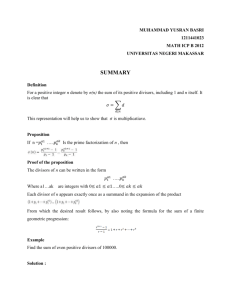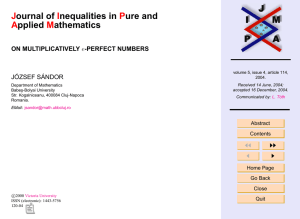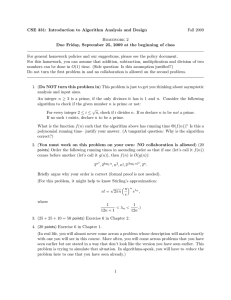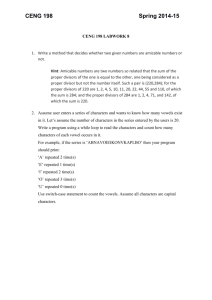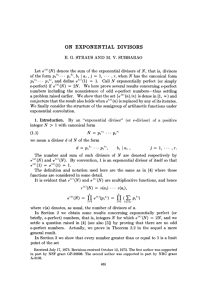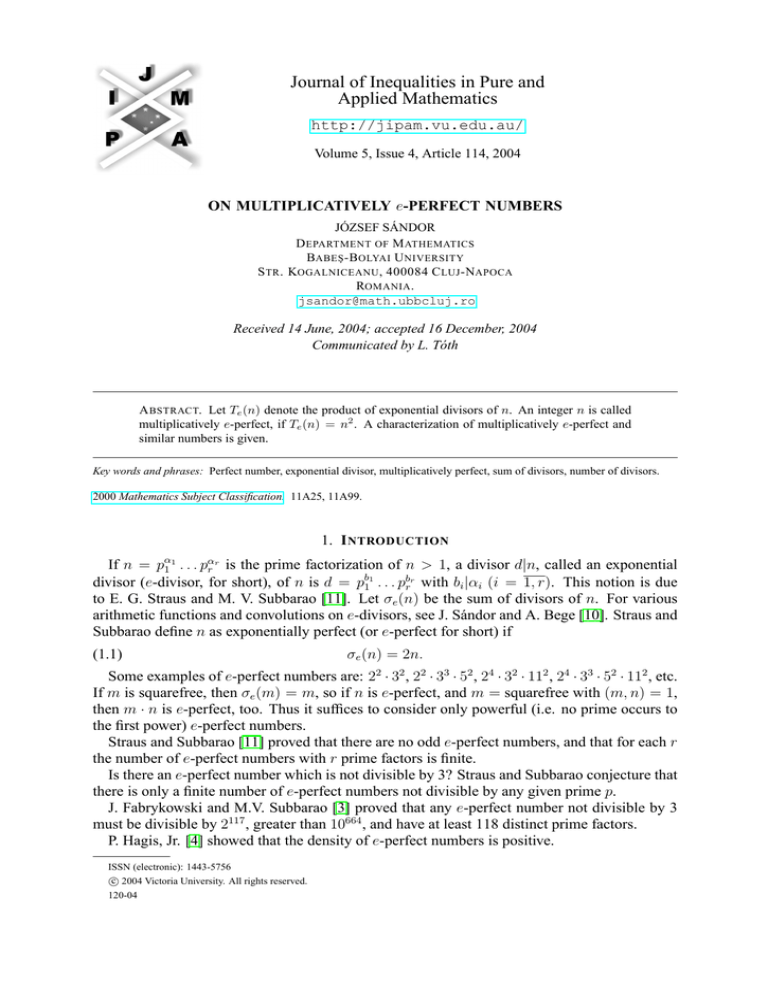
Journal of Inequalities in Pure and
Applied Mathematics
http://jipam.vu.edu.au/
Volume 5, Issue 4, Article 114, 2004
ON MULTIPLICATIVELY e-PERFECT NUMBERS
JÓZSEF SÁNDOR
D EPARTMENT OF M ATHEMATICS
BABE Ş -B OLYAI U NIVERSITY
S TR . KOGALNICEANU , 400084 C LUJ -NAPOCA
ROMANIA .
jsandor@math.ubbcluj.ro
Received 14 June, 2004; accepted 16 December, 2004
Communicated by L. Tóth
A BSTRACT. Let Te (n) denote the product of exponential divisors of n. An integer n is called
multiplicatively e-perfect, if Te (n) = n2 . A characterization of multiplicatively e-perfect and
similar numbers is given.
Key words and phrases: Perfect number, exponential divisor, multiplicatively perfect, sum of divisors, number of divisors.
2000 Mathematics Subject Classification. 11A25, 11A99.
1. I NTRODUCTION
If n = pα1 1 . . . pαr r is the prime factorization of n > 1, a divisor d|n, called an exponential
divisor (e-divisor, for short), of n is d = pb11 . . . pbrr with bi |αi (i = 1, r). This notion is due
to E. G. Straus and M. V. Subbarao [11]. Let σe (n) be the sum of divisors of n. For various
arithmetic functions and convolutions on e-divisors, see J. Sándor and A. Bege [10]. Straus and
Subbarao define n as exponentially perfect (or e-perfect for short) if
(1.1)
σe (n) = 2n.
Some examples of e-perfect numbers are: 22 · 32 , 22 · 33 · 52 , 24 · 32 · 112 , 24 · 33 · 52 · 112 , etc.
If m is squarefree, then σe (m) = m, so if n is e-perfect, and m = squarefree with (m, n) = 1,
then m · n is e-perfect, too. Thus it suffices to consider only powerful (i.e. no prime occurs to
the first power) e-perfect numbers.
Straus and Subbarao [11] proved that there are no odd e-perfect numbers, and that for each r
the number of e-perfect numbers with r prime factors is finite.
Is there an e-perfect number which is not divisible by 3? Straus and Subbarao conjecture that
there is only a finite number of e-perfect numbers not divisible by any given prime p.
J. Fabrykowski and M.V. Subbarao [3] proved that any e-perfect number not divisible by 3
must be divisible by 2117 , greater than 10664 , and have at least 118 distinct prime factors.
P. Hagis, Jr. [4] showed that the density of e-perfect numbers is positive.
ISSN (electronic): 1443-5756
c 2004 Victoria University. All rights reserved.
120-04
2
J ÓZSEF S ÁNDOR
For results on e-multiperfect numbers, i.e. satisfying
σe (n) = kn
(1.2)
(k > 2), see W. Aiello, G. E. Hardy and M. V. Subbarao [1]. See also J. Hanumanthachari, V.
V. Subrahmanya Sastri and V. Srinivasan [5], who considered also e-superperfect numbers, i.e.
numbers n satisfying
σe (σe (n)) = 2n.
(1.3)
2. M AIN R ESULTS
Let T (n) denote the product of divisors of n. Then n is said to be multiplicatively perfect (or
m-perfect) if
T (n) = n2
(2.1)
and multiplicatively super-perfect, if
T (T (n)) = n2 .
For properties of these numbers, with generalizations,
see J. Sándor [8].
A divisor d of n is said to be "unitary" if d, nd = 1. Let T ∗ (n) be the product of unitary
divisors of n. A. Bege [2] has studied the multiplicatively unitary perfect numbers, and proved
certain results similar to those of Sándor. He considered also the case of "bi-unitary" divisors.
The aim of this paper is to study the multiplicatively e-perfect numbers. Let Te (n) denote the
product of e-divisors of n. Then n is called multiplicatively e-perfect if
Te (n) = n2 ,
(2.2)
and multiplicatively e-superperfect if
Te (Te (n)) = n2 .
(2.3)
The main result is contained in the following:
Theorem 2.1. n is multiplicatively e-perfect if and only if n = pα , where p is a prime and α is
an ordinary perfect number. n is multiplicatively e-superperfect if and only if n = pα , where p
is a prime, and α is an ordinary superperfect number, i.e. σ(σ(α)) = 2α.
Proof. First remark that if p prime,
P
α
Te (p ) =
Y
α
p =p
d|α
d
= pσ(α) .
d|α
Let n = pα1 1 · · · pαr r . Then the exponential divisors of n have the form pd11 · · · pdr r where
dr−1 d
d1 |α1 , . . . , dr |αr . If d1 , . . . , dr−1 are fixed, then these divisors are pd11 · · · pr−1
pr with d|αr
d1 d(αr )
dr−1 d(αr ) σ(αr )
and the product of these divisors is p1
· · · pr−1
pr
, where d(a) is the number of
divisors of a, and σ(a) denotes the sum of divisors of a. For example, when r = 2, we get
d d(α ) σ(α )
σ(d )d(α ) σ(α )d(α )
p11 2 p2 2 . The product of these divisors is p1 1 2 p2 2 1 . In the general case (by first
fixing d1 , . . . , dr−2 , etc.), it easily follows by induction that the following formula holds true:
(2.4)
σ(α1 )d(α2 )···d(αr )
Te (n) = p1
r )d(α1 )···d(αr−1 )
· · · pσ(α
r
Now, if n is multiplicatively e-perfect, by (2.2), and the unique factorization theorem it follows
that
σ(α1 )d(α2 ) · · · d(αr ) = 2α1
···
(2.5)
.
σ(α )d(α ) · · · d(α ) = 2α
r
1
r−1
r
J. Inequal. Pure and Appl. Math., 5(4) Art. 114, 2004
http://jipam.vu.edu.au/
O N M ULTIPLICATIVELY e-P ERFECT N UMBERS
3
This is impossible if all αi = 1 (i = 1, r). If at least an αi = 1, let α1 = 1. Then
d(α2 ) · · · d(αr ) = 2, so one of α2 , . . . , αr is a prime, the others are equal to 1. Let α2 = p,
α3 = · · · = αr = 1. But then the equation σ(α2 )d(α1 )d(α3 ) · · · d(αr ) = 2α2 of (2.5) gives
σ(α2 ) = 2α2 , i.e. σ(p) = 2p, which is impossible since p + 1 = 2p.
Therefore, we must have αi ≥ 2 for all i = 1, r.
Let r ≥ 2 in (2.5). Then the first equation of (2.5) implies
σ(α1 )d(α2 ) · · · d(αr ) ≥ (α1 + 1) · 2r−1 ≥ 2(α1 + 1) > 2α1 ,
σ(α )
which is a contradiction. Thus we must have r = 1, when n = pα1 1 and Te (n) = p1 1 = n2α1
iff σ(α1 ) = 2α1 , i.e. if α1 is an ordinary perfect number. This proves the first part of the
theorem.
By (2.4) we can write the following complicated formula:
σ(σ(α1 )d(α2 )···d(αr ))···d(σ(αr )d(α1 )···d(αr−1 ))
(2.6) Te (Te (n)) = p1
r )d(α1 )···d(αr−1 ))···d(σ(α1 )d(α2 )···d(αr ))
· · · pσ(σ(α
.
r
Thus, if n is multiplicatively e-superperfect, then
σ(σ(α1 )d(α2 ) · · · d(αr )) · · · d(σ(αr )d(α1 ) · · · d(αr−1 )) = 2α1
···
(2.7)
.
σ(σ(α )d(α ) · · · d(α )) · · · d(α(α )d(α ) · · · d(α )) = 2α
r
1
r−1
1
2
r
r
As above, we must have αi ≥ 2 for all i = 1, 2, . . . , r.
But then, since σ(ab) ≥ aσ(b) and σ(b) ≥ b+1 for b ≥ 2, (2.7) gives a contradiction, if r ≥ 2.
σ(σ(α1 ))
σ(α )
,
For r = 1, on the other hand, when n = pα1 1 and Te (n) = p1 1 we get Te (Te (n)) = p1
and (2.3) implies σ(σ(α1 )) = 2α1 , i.e. α1 is an ordinary superperfect number.
Remark 2.2. No odd ordinary perfect or superperfect number is known. The even ordinary
perfect numbers are given by the well-known Euclid-Euler theorem: n = 2k p, where p =
2k+1 − 1 is a prime ("Mersenne prime"). The even superperfect numbers have the general form
(given by Suryanarayana-Kanold [12], [6]) n = 2k , where 2k+1 − 1 is a prime. For new proofs
of these results, see e.g. [7], [9].
R EFERENCES
[1] W. AIELLO, G.E. HARDY AND M.V. SUBBARAO, On the existence of e-multiperfect numbers,
Fib. Quart., 25 (1987), 65–71.
[2] A. BEGE, On multiplicatively unitary perfect numbers, Seminar on Fixed Point Theory, ClujNapoca, 2 (2001), 59–63.
[3] J. FABRYKOWSKI AND M.V. SUBBARAO, On e-perfect numbers not divisible by 3, Nieuw
Arch. Wiskunde, 4(4) (1986), 165–173.
[4] P. HAGIS, JR., Some results concerning exponential divisors, Intern. J. Math. Math. Sci., 11(1988),
343–349.
[5] J. HANUMANTHACHARI, V.V. SUBRAHMANYA SASTRI
perfect numbers, Math. Student, 46(1) (1978), 71–80.
AND
V. SRINIVASAN, On e-
[6] H.J. KANOLD, Über super-perfect numbers, Elem. Math., 24(1969), 61–62.
[7] J. SÁNDOR, On the composition of some arithmetic functions, Studia Univ. Babeş-Bolyai Math.,
34(1) (1989), 7–14.
[8] J. SÁNDOR, On multiplicatively perfect numbers, J. Ineq. Pure Appl. Math., 2(1) (2001), Art. 3, 6
pp. (electronic). [ONLINE http://jipam.vu.edu.au/article.php?sid=119]
J. Inequal. Pure and Appl. Math., 5(4) Art. 114, 2004
http://jipam.vu.edu.au/
4
J ÓZSEF S ÁNDOR
[9] J. SÁNDOR, On an even perfect and superperfect number, Notes Number Theory Discr. Math., 7(1)
(2001), 4–5.
[10] J. SÁNDOR AND A. BEGE, The Möbius function: generalizations and extensions, Adv. Stud.
Contemp. Math., 6(2) (2003), 77–128.
[11] E.G. STRAUS
471.
AND
M.V. SUBBARAO, On exponential divisors, Duke Math. J., 41 (1974), 465–
[12] D. SURYANARAYANA, Super-perfect numbers, Elem. Math., 24 (1969), 16–17.
J. Inequal. Pure and Appl. Math., 5(4) Art. 114, 2004
http://jipam.vu.edu.au/

